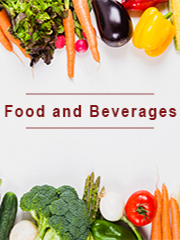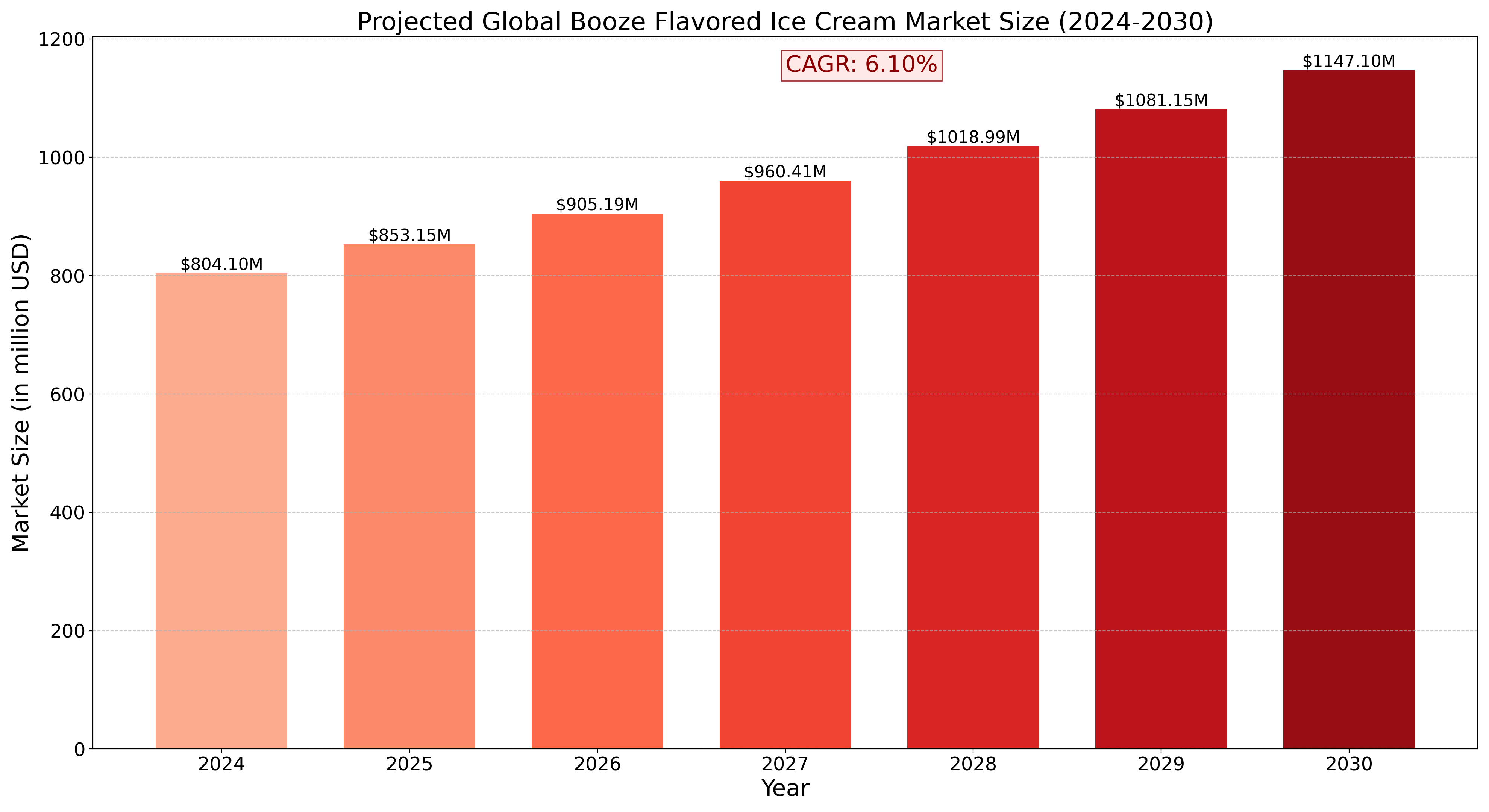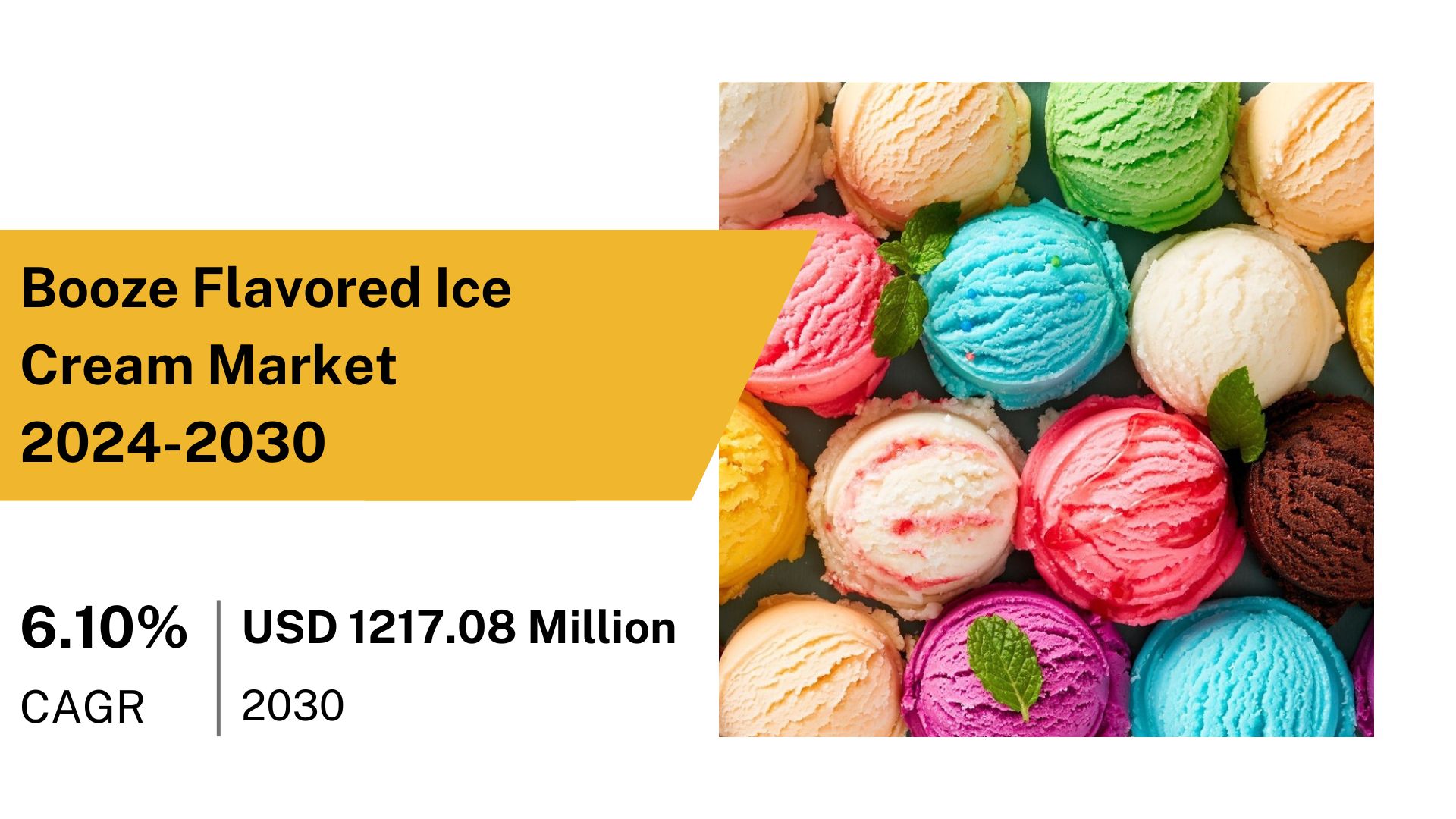TOP CATEGORY: Chemicals & Materials | Life Sciences | Banking & Finance | ICT Media

Download Report PDF Instantly
Report overview
The "Global Booze Flavored Ice Cream Market" Size was estimated at USD 804.10 Million in 2024 and is projected to reach USD 1217.08 Million by 2030, exhibiting a CAGR of 6.10% during the forecast period.
Booze-flavored ice cream is a niche product that combines the indulgence of ice cream with the allure of alcohol. This market has gained traction as consumers seek novel, premium desserts, particularly in segments like gourmet, artisanal, and adult-oriented indulgences. As the trend of adult desserts continues to rise, this hybrid product is creating new opportunities in the frozen dessert space.

Key End-User Segments:
Retailers and Supermarkets:
Market Share: Retailers and supermarkets contribute around 40-45% of the booze-flavored ice cream market.
Key Trends:
Supermarkets are increasingly offering premium and specialty ice creams in their frozen dessert aisles, including alcoholic flavors like bourbon, whiskey, rum, and wine-infused varieties.
Many large retail chains are dedicating freezer space to boutique brands that produce alcohol-infused ice creams, capitalizing on consumer demand for artisanal, high-end dessert experiences.
Grocery stores are targeting millennials and Gen Z consumers, who are more inclined to experiment with unconventional and unique dessert flavors.
Consumer Preferences: Convenience, along with the novelty of boozy flavors, is driving more consumers to pick up alcohol-flavored ice creams as they shop for gourmet experiences at home.
Restaurants and Bars:
Market Share: Restaurants, bars, and foodservice establishments account for about 30-35% of the market.
Usage: Booze-flavored ice creams are featured in high-end restaurants, gourmet dessert menus, and upscale bars that serve them as part of dessert pairings or innovative cocktails.
Key Trends:
Upscale dining venues and bars are incorporating boozy ice creams into their menus to create exclusive dessert options that appeal to adult clientele.
The popularity of craft cocktails has extended to frozen desserts, with some establishments creating signature alcoholic ice cream flavors in-house.
Bars and eateries offering “adult milkshakes” and ice cream-based cocktails featuring these boozy desserts are becoming more popular, particularly in urban areas with trendy food scenes.
Consumer Preferences: Adults are increasingly seeking new experiences when dining out, opting for sophisticated and experimental desserts that incorporate both ice cream and alcohol.
Specialty Ice Cream Parlors:
Market Share: Specialty ice cream parlors represent approximately 10-15% of the market.
Key Trends:
Ice cream parlors offering handcrafted, artisanal ice cream are seeing a surge in demand for alcohol-infused flavors. Many such establishments are capitalizing on the trend by creating limited-edition boozy ice cream flavors to attract niche customers.
Boutique ice cream shops often promote locally sourced ingredients and artisanal methods, appealing to customers who value quality and craftsmanship in their desserts.
Pop-up events, food festivals, and collaborations with local breweries and distilleries are increasingly becoming avenues for promoting these boozy treats.
Consumer Preferences: Consumers visiting specialty ice cream shops are looking for premium and exotic flavors, including those with alcohol infusions, to indulge in small-batch, gourmet offerings.
Event Catering Services:
Market Share: Event caterers, including those serving weddings, corporate events, and private parties, contribute around 5-8% of the market.
Key Trends:
Booze-flavored ice cream is increasingly featured at high-end events and celebrations where there is a demand for unique and memorable culinary experiences. Caterers are offering customizable flavors that reflect event themes, such as champagne-flavored ice cream for weddings.
Corporate events and private parties are using these products to create buzz-worthy dessert experiences that are both luxurious and fun.
Consumer Preferences: Clients hosting events are choosing boozy ice creams as a unique, adult-friendly dessert option to surprise and delight their guests, particularly for evening events where alcohol is already being served.
Household Consumers:
Market Share: Household consumers represent around 5-10% of the booze-flavored ice cream market.
Buying Behavior:
Many consumers are purchasing booze-flavored ice cream for special occasions, such as holidays or social gatherings at home, where they want to impress guests with something distinctive.
With the growing trend of “stay-at-home indulgence,” consumers are treating themselves to high-end boozy desserts as part of their personal entertainment or for pairing with after-dinner drinks.
Key Trends:
The rise of online grocery shopping and delivery services has made it easier for consumers to access booze-flavored ice creams from specialty stores or boutique brands.
Home consumers are also experimenting with creating their own versions of alcohol-infused ice creams, leading to a growing interest in DIY recipes and kits.
Regional Insights:
North America:
Market Share: North America leads the market with approximately 45-50% of global consumption.
Key Markets: The U.S. dominates, driven by innovation in premium ice cream and a strong cocktail culture.
Trends: The presence of well-established artisanal ice cream brands and a penchant for alcohol-based desserts are key factors driving growth. Regulatory considerations related to the alcohol content in frozen desserts have also shaped the market.
Europe:
Market Share: Europe holds about 20-25% of the market.
Key Markets: The UK, Germany, and France are notable consumers of booze-flavored ice creams, especially in urban areas with a strong gourmet food culture.
Trends: Europeans' preference for fine dining and artisanal foods is boosting the adoption of alcohol-infused ice creams, particularly in gourmet restaurants and specialty stores.
Asia-Pacific:
Market Share: Asia-Pacific represents around 15-20% of the global market.
Key Drivers: Japan, South Korea, and Australia are emerging markets where the fusion of Western dessert concepts with local flavors is gaining popularity.
Trends: Booze-flavored ice cream is seen as a premium, indulgent dessert option, attracting younger generations who are more open to trying innovative, Western-style desserts.
This report provides a deep insight into the global Booze Flavored Ice Cream market covering all its essential aspects. This ranges from a macro overview of the market to micro details of the market size, competitive landscape, development trend, niche market, key market drivers and challenges, SWOT analysis, Porters five forces analysis, value chain analysis, etc.

The analysis helps the reader to shape the competition within the industries and strategies for the competitive environment to enhance the potential profit. Furthermore, it provides a simple framework for evaluating and accessing the position of the business organization. The report structure also focuses on the competitive landscape of the Global Booze Flavored Ice Cream Market, this report introduces in detail the market share, market performance, product situation, operation situation, etc. of the main players, which helps the readers in the industry to identify the main competitors and deeply understand the competition pattern of the market.
In a word, this report is a must-read for industry players, investors, researchers, consultants, business strategists, and all those who have any kind of stake or are planning to foray into the Booze Flavored Ice Cream market in any manner.
Global Booze Flavored Ice Cream Market: Market Segmentation Analysis
The research report includes specific segments by region (country), manufacturers, Type, and Application. Market segmentation creates subsets of a market based on product type, end-user or application, Geographic, and other factors. By understanding the market segments, the decision-maker can leverage this targeting in the product, sales, and marketing strategies. Market segments can power your product development cycles by informing how you create product offerings for different segments.
Key Company:
Haagen-Dazs Nederland
Tipsy Scoop
Mercer's Dairy
Baileys
Ben & Jerry
Moutai
Aubi & Ramsa
Snobar
Jeni Britton Bauer
Proof
Speakeasy
Van Leeuwen
Arctic Buzz
BuzzBar
By Type:
Wine
Vodka
Rum
Others
By Application:
Online Sales
Offline Sales
Geographic Segmentation:
North America (USA, Canada, Mexico)
Europe (Germany, UK, France, Russia, Italy, Rest of Europe)
Asia-Pacific (China, Japan, South Korea, India, Southeast Asia, Rest of Asia-Pacific)
South America (Brazil, Argentina, Columbia, Rest of South America)
The Middle East and Africa (Saudi Arabia, UAE, Egypt, Nigeria, South Africa, Rest of MEA)
Key Benefits of This Market Research:
Industry drivers, restraints, and opportunities covered in the study
Neutral perspective on the market performance
Recent industry trends and developments
Competitive landscape & strategies of key players
Potential & niche segments and regions exhibiting promising growth covered
Historical, current, and projected market size, in terms of value
In-depth analysis of the Booze Flavored Ice Cream Market
Key Reasons to Buy this Report:
Access to date statistics compiled by our researchers. These provide you with historical and forecast data, which is analyzed to tell you why your market is set to change
This enables you to anticipate market changes to remain ahead of your competitors
You will be able to copy data from the Excel spreadsheet straight into your marketing plans, business presentations, or other strategic documents
The concise analysis, clear graph, and table format will enable you to pinpoint the information you require quickly
Provision of market value (USD Billion) data for each segment and sub-segment
Indicates the region and segment that is expected to witness the fastest growth as well as to dominate the market
Analysis by geography highlighting the consumption of the product/service in the region as well as indicating the factors that are affecting the market within each region
Competitive landscape which incorporates the market ranking of the major players, along with new service/product launches, partnerships, business expansions, and acquisitions in the past five years of companies profiled
Extensive company profiles comprising of company overview, company insights, product benchmarking, and SWOT analysis for the major market players
The current as well as the future market outlook of the industry concerning recent developments which involve growth opportunities and drivers as well as challenges and restraints of both emerging as well as developed regions
Includes in-depth analysis of the market from various perspectives through Porters five forces analysis
Provides insight into the market through Value Chain
Market dynamics scenario, along with growth opportunities of the market in the years to come
6-month post-sales analyst support
Chapter Outline
Chapter 1 mainly introduces the statistical scope of the report, market division standards, and market research methods.
Chapter 2 is an executive summary of different market segments (by region, product type, application, etc), including the market size of each market segment, future development potential, and so on. It offers a high-level view of the current state of the Booze Flavored Ice Cream Market and its likely evolution in the short to mid-term, and long term.
Chapter 3 makes a detailed analysis of the Market's Competitive Landscape of the market and provides the market share, capacity, output, price, latest development plan, merger, and acquisition information of the main manufacturers in the market.
Chapter 4 is the analysis of the whole market industrial chain, including the upstream and downstream of the industry, as well as Porter's five forces analysis.
Chapter 5 introduces the latest developments of the market, the driving factors and restrictive factors of the market, the challenges and risks faced by manufacturers in the industry, and the analysis of relevant policies in the industry.
Chapter 6 provides the analysis of various market segments according to product types, covering the market size and development potential of each market segment, to help readers find the blue ocean market in different market segments.
Chapter 7 provides the analysis of various market segments according to application, covering the market size and development potential of each market segment, to help readers find the blue ocean market in different downstream markets.
Chapter 8 provides a quantitative analysis of the market size and development potential of each region and its main countries and introduces the market development, future development prospects, market space, and capacity of each country in the world.
Chapter 9 introduces the basic situation of the main companies in the market in detail, including product sales revenue, sales volume, price, gross profit margin, market share, product introduction, recent development, etc.
Chapter 10 provides a quantitative analysis of the market size and development potential of each region in the next five years.
Chapter 11 provides a quantitative analysis of the market size and development potential of each market segment (product type and application) in the next five years.
Chapter 12 is the main points and conclusions of the report.